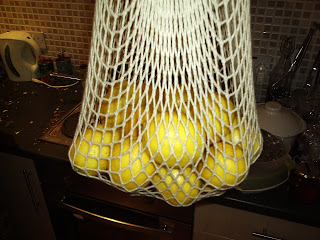Inspired by Austerity Britain and feeling adventurous, we decided, some months ago now, to turn our hands to the endangered art of rhubarb-bottling. Aided and indeed abetted by this Grauniad food blog, we set about collating the necessary.
Rhubarb was our first concern. We have a rhubarb plant but it's not yet a year old and wasn't able to supply our prodigious needs. Fortunately, Hazel's farm has, in common with many such establishments, a neglected patch of rhubarb malingering round the back. She donned wellingtons and, armed with sharpened secateurs, slew enough for our bountiful bottling.
Next, the jars. There's a bit of a rammy going on in the comments of the linked blog post about the relative merits of Leifheit and Kilner jars, but for us it was simple - we could only get Kilner, which in any case fitted our patriotic milieu . The imposing assistant at John Lewis told us they were the best anyway, and that was good enough for us. Much later we did find some Leifheit ones at Marchmont Hardware, our local hardware shop, so they themselves may make an appearance in the future (they're on top of our cupboards now)
We were ready to go.
Washing the rhubarb took longer than I expected, giving it a good scrub to remove all that Aberdeenshire earth. We only have a photograph of that taken with the webcam built in to my laptop. Here it is:

The rest of the kitchen was really clean, honest.
While one of us was doing that, the other made a sugar syrup to put the rhubarb in.
This was all time-consuming, but relatively easy. We put the rhubarb into the syrup and left it there until the following evening, with a lid over it.
The next day it smelled beautiful when we lifted the lid off, ready for the most complex stage. We packed the rhubarb into our jars, but could certainly have packed more in. We didn't quite take seriously enough the recipe's stipulations to pack them in like commuters in a rush hour, not properly appreciating that the rhubarb cooks inside the jar in the next part of the process. No appreciable harm was done, but there are gaps in the finished product. The reboiled syrup topped up the jars and they were sealed up, then released a little bit just to let the air out.
Not having an actual jam pan caused us some difficulty here, as we were using the monstrous stock pot seen elsewhere on this blog with steep, tall sides, so manoeuvring the jars in and out was a challenge. We sat them on a teatowel and fretted as there was only just room for them all in the pan without them touching. We fretted some more about the concept of bringing to the boil over half an hour on an electric hob that always seemed over-eager to provide great quantities of heat. We mainly achieved an approximation of accuracy by turning it up one, fretting a bit, then turning it down. In the end, it took longer than half an hour to bring to the boil, because we feared the consequences of being too quick. While the pan of water they were immersed in boiled, the jars expelled air in a flatulent manner, which was pleasing to one so juvenile as I. We then bundled them inexpertly out of the water and sat watching them anxiously for the pop that signifies a seal. Incidentally, we were worried, given the sustained period of heating endured by everything in the pan, that we would burn the teatowel horribly. In the end it came out slightly singed, but still usable and everything. Don't however, use an heirloom or anything you mind getting, well, slightly singed.
All three jars gave a very satisfying pop one after the other and are now sitting in our cupboard. We're open to suggestions for their use.


















